ตารางการให้อาหารที่ดีที่สุดสำหรับพืชออโต้ฟลาวเวอร์
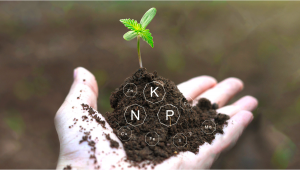
- 1. ทำไมถึงเลือกปลูกกัญชาแบบออกดอกอัตโนมัติ
- 1. a. แต่อะไรคือกัญชาออกดอกอัตโนมัติและอะไรที่ทำให้กัญชาชนิดนี้พิเศษและไม่เหมือนใคร?
- 2. ประเภทของสารอาหารที่แตกต่างกัน
- 3. ปุ๋ยสำหรับช่วงระยะต้นกล้า
- 4. ปุ๋ยสำหรับระยะเจริญเติบโตของพืช
- 5. ธาตุอาหารสำหรับระยะก่อนออกดอกและระยะออกดอก
- 6. ตารางการให้ปุ๋ยสำหรับพืชออโต้ (ปุ๋ยชนิดเหลว)
- 6. a. แผนการให้ปุ๋ยอินทรีย์สำหรับพืชออโต้ (ปุ๋ยผง)
- 7. การให้สารอาหารมากเกินไป
- 8. สารอาหารไม่เพียงพอ
- 9. การล้างราก (flushing) และเวลาที่ควรหยุดให้อาหาร
- 10. ยี่ห้อปุ๋ยกัญชาที่ดีที่สุด
- 10. a. ตัวเลือกอื่นๆที่ยอดเยี่ยม
- 11. สรุป
พืชกัญชาแบบออโต้ฟลาวเวอร์ทั้งหมดเช่นเดียวกับพืชอื่น ๆ ต้องการสารอาหารเพื่อที่จะอยู่รอดและเจริญเติบโต สารอาหารของพืชถูกแบ่งออกเป็นสารอาหารหลักและสารอาหารรอง สารอาหารหลัก (Macronutrients) คือสารอาหารที่พืชใช้ในปริมาณมาก ประกอบด้วยไนโตรเจน (Nitrogen, N), ฟอสฟอรัส (Phosphorus, P), และโพแทสเซียม (Potassium, K) สารอาหารรอง (Micronutrients) เป็นธาตุที่สำคัญเป็นองค์ประกอบที่สองและถูกดูดซึมเข้าสู่พืชในปริมาณเล็กน้อยกว่า ประกอบด้วยแมกนีเซียม (Magnesium, Mg), แคลเซียม (Calcium, Ca), กำมะถัน (Sulfur, Su), ทองแดง (Copper, Cu), สังกะสี (Zinc, Zn), เหล็ก (Iron, Fe), แมงกานีส (Manganese, Mn) รวมถึงธาตุอื่น ๆ
สารอาหารทั้งหลักและรองจะถูกนำเสนอผ่านการให้อาหารด้วยการรดน้ำผสมสารอาหาร ดินที่ผ่านการเตรียมล่วงหน้า หรือผงปล่อยออกช้า เมื่อให้อาหาร โปรดจำไว้ว่าคุณสามารถเพิ่มปริมาณสารอาหารได้เสมอ แต่ไม่สามารถลดปริมาณได้
สารอาหารส่วนใหญ่ถูกออกแบบมาสำหรับพืชที่มีระยะแสงวันยาว (photoperiodic) ซึ่งอาจทำให้เกิดความยากต่อการให้อาหารที่เหมาะสมแก่พืชออโต้ฟลาวเวอร์ ซึ่งอาจทำให้มีโอกาสให้ปุ๋ยมากหรือน้อยเกินไปและส่งผลให้พืชเสียหายได้ นั่นเป็นเหตุผลที่เราขอแนะนำให้คุณปฏิบัติตามตารางการให้อาหารที่ดีที่สุดสำหรับพืชออโต้ฟลาวเวอร์ ซึ่งได้รับการปรับแต่งให้เหมาะสมสำหรับการเพาะปลูกออโต้ฟลาวเวอร์โดยใช้สารอาหารที่ออกแบบมาสำหรับพืชที่มีระยะแสงวันยาว
- สัปดาห์ที่ 0 การงอกเมล็ด - ใช้น้ำปกติ
- สัปดาห์ที่ 1 ต้นกล้า - ใช้น้ำปกติ
- สัปดาห์ที่ 2 การเจริญเติบโต - ใช้ปุ๋ยสำหรับการเจริญเติบโต สัดส่วน ⅛
- สัปดาห์ที่ 3 การเจริญเติบโต - ใช้ปุ๋ยสำหรับการเจริญเติบโต สัดส่วน ¼
- สัปดาห์ที่ 4 การเจริญเติบโต - ใช้ปุ๋ยสำหรับการเจริญเติบโต สัดส่วน ¼ ถึง ½
- สัปดาห์ที่ 5 ก่อนออกดอก - ใช้ปุ๋ยสำหรับการเจริญเติบโต สัดส่วน ¼ + สัดส่วน ⅛ ของปุ๋ยในช่วงดอกบาน
- สัปดาห์ที่ 6 การออกดอก - ใช้ปุ๋ยสำหรับดอกบาน สัดส่วน ¼ + สัดส่วน ⅛ ของปุ๋ยในช่วงการเจริญเติบโต
- สัปดาห์ที่ 7 การออกดอก - ใช้ปุ๋ยสำหรับดอกบาน สัดส่วน ¼
- สัปดาห์ที่ 8 การออกดอก - ใช้ปุ๋ยสำหรับดอกบานสัดส่วน ½
- สัปดาห์ที่ 9 การออกดอก - ใช้ปุ๋ยสำหรับดอกบาน สัดส่วน ½
- สัปดาห์ที่ 10 การสุกแก่ - ใช้ปุ๋ยสำหรับดอกบาน สัดส่วน ⅛
- สัปดาห์ที่ 11 การฟลัช - ใช้น้ำปกติ
1. ทำไมถึงเลือกปลูกกัญชาแบบออกดอกอัตโนมัติ
กัญชาออกดอกอัตโนมัติคือเด็กใหม่บนบล็อก แต่ไม่จริงอีกต่อไปพืชออกดอกอัตโนมัติจริงๆ อยู่มาหลายทศวรรษแล้ว แต่จริงๆเป็นเวลาแค่ 6 ปีที่ผ่านมาที่เราได้เห็นพันธุกรรมเริ่มแสดงให้เห็นถึงความสามารถที่แท้จริงของพืชชนิดนี้ในเรื่องของเปอร์เซ็นต์ของสารกัญชาและโปรไฟล์ของเทอร์ปีน ทำให้พันธุ์แบบแสงวันยาวถูกแทนที่ได้ในเรื่องรายได้ การพัฒนานี้เป็นผลมาจากบริษัทเมล็ดพันธุ์และผู้ประพันธ์ที่มุ่งมั่นเพียงไม่กี่รายเท่านั้น และหากไม่มีความมุ่งมั่นของกลุ่มเล็กน้อยนี้เราอาจจะไม่มีวันได้เห็นความยอดเยี่ยมที่แท้จริงของกัญชาแบบออโต้ฟลาวเวอร์
แต่อะไรคือกัญชาออกดอกอัตโนมัติและอะไรที่ทำให้กัญชาชนิดนี้พิเศษและไม่เหมือนใคร?
กัญชาออโต้นั้นมีความเป็นเอกลักษณ์ในหลายด้าน แต่มีคุณสมบัติที่สำคัญที่ทำให้เด่นจริงๆ ชื่ออาจจะบอกให้เดาได้แล้ว ด้วยการตั้งเวลาอัตโนมัติที่มาจากพันธุกรรมของกัญชาลูราลิส (ซึ่งเป็นสายพันธุ์แยกต่างหากจากอินดิก้าและซาติว่าที่เป็นที่รู้จักดี) - กัญชาออโต้จะสลับจากขั้วการเจริญเติบโตในช่วงเวลาของการออกดอกไม่ว่าไฟจะเป็นยังไงก็ตาม สำหรับสายพันธุ์โฟโต้เป็นพืชกัญชาที่ต้องการเวลาในการเจริญเติบโตและการออกดอกที่กำหนดโดยปริมาณแสงที่ให้กับพืชในแต่ละวัน ตราบเท่าที่พืชอยู่ใต้แสงไฟมากกว่า 18 ชั่วโมงในรอบ 24 ชั่วโมง พืชจะอยู่ในช่วงการเจริญเติบโตในระยะเวลาของใบเขียว และเมื่อคุณพร้อมที่จะให้พืชบังคับให้ออกดอกคุณเพียงแค่ปรับเวลาการให้แสงไฟให้เป็น 12 ชั่วโมงต่อวัน พืชจะทำงานที่เหลือให้เอง
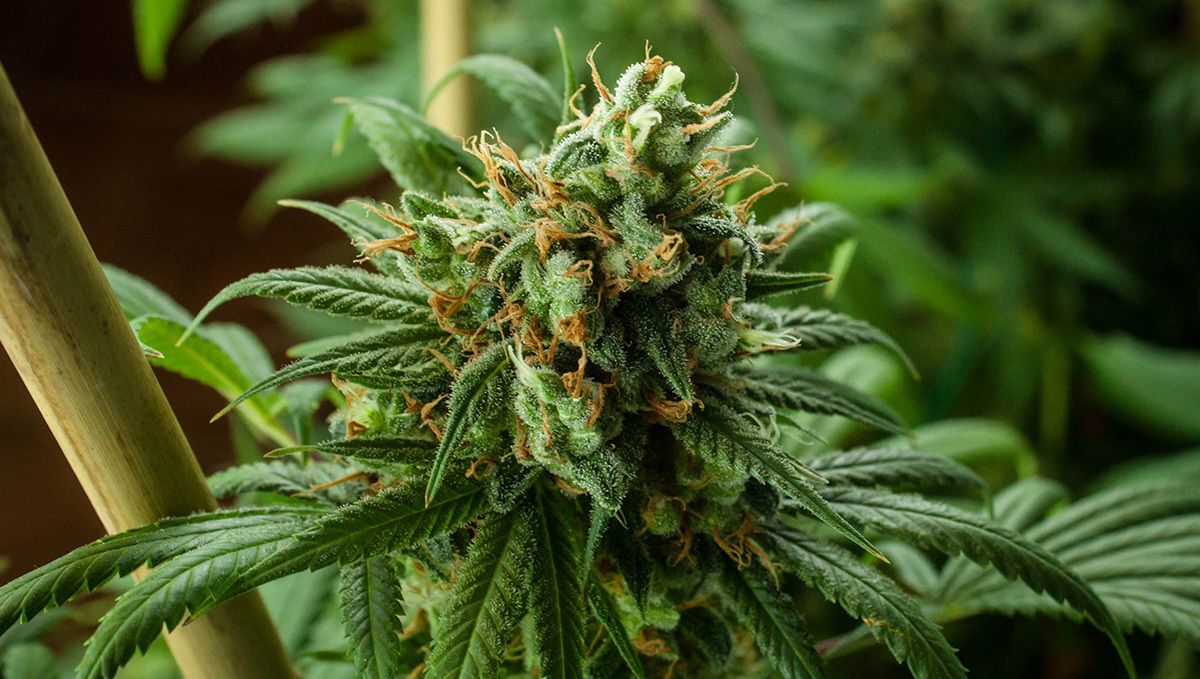
กับกัญชาออโต้คุณสามารถให้แสงไฟเปิดติดต่อกัน 24 ชั่วโมงต่อวันหากคุณต้องการ (แม้ว่าเราจะไม่แนะนำให้ทำเช่นนี้) และพืชก็ยังจะเริ่มออกดอกอยู่เช่นเดียว สิ่งนี้ให้ผู้ปลูกมีประโยชน์ในหลายด้านและความสะดวกสบายในการให้แสงไฟไม่ใช่เพียงอย่างเดียว มาเรียนรู้เหตุผลทั้งหมดที่ทำให้ผู้ปลูกมากมายตัดสินใจสลับจากกัญชาโฟโต้เป็นกัญชาออโต้ในฟาร์มทั้งภายในและภายนอก
พันธุศาสตร์ที่ยืดหยุ่น
บัดนี้สิ่งที่ทำให้กัญชาออโต้มีความทนทานต่อสิ่งแวดล้อมมากคือการมีพันธุกรรมของกัญชาลูราลิส โดยเฉพาะเมื่อเปรียบเทียบกับสายพันธุ์โฟโต้ ลูราลิสมีต้นกำเนิดในยุโรปตะวันออกและซิบีเรีย ซึ่งหมายความว่าสายพันธุ์ออโต้บางสายพันธุ์สามารถทนทานต่ออุณหภูมิที่เย็นมากขึ้น ระดับความสูงของที่ราบสูง ช่วงความชื้นที่หลากหลายกว้างขึ้น และสภาพอากาศที่หนักแน่นขึ้นโดยทั่วไป
มีความปกปิดมากขึ้น
ด้วยความสูงที่เล็กกว่า กัญชาออโต้มักจะมีความปกปิดมากกว่าสายพันธุ์ทั่วไป แน่นอนว่ามีสายพันธุ์ออโต้บางสายพันธุ์ที่มีความสูงสุดถึง 1.5 เมตร (5 ฟุต) เมื่อเติบโตเต็มที่ แต่ก็ยังมีสายพันธุ์ออโต้อีกมากที่สั้นกว่า 1 เมตร (3 ฟุต) ซึ่งทำให้เหมาะสำหรับผู้ปลูกที่ต้องการพืชที่ง่ายต่อการซ่อนเร้นและไม่ต้องเป็นที่สังเกตเห็น
ต้องการสารอาหารปริมาณน้อย
โดยทั่วไปแล้ว สายพันธุ์กัญชาออโต้ต้องการสารอาหารน้อยกว่าสายพันธ์ุโฟโต้ นี้ทำให้ตารางการให้ปุ๋ยง่ายขึ้นและลดค่าใช้จ่ายในการปลูกลง ปุ๋ยคุณภาพสูงไม่ได้ราคาถูกเลยเสมอ ดังนั้นการปลูกกัญชาออโต้จะช่วยให้ได้ผลลัพธ์ที่ดีกว่าในราคาที่ถูกกว่า
วงจรชีวิตที่รวดเร็ว
สายพันธุ์กัญชาโฟโต้ในส่วนมากจะใช้เวลาอย่างน้อย 4 เดือนเพื่อเติบโตจากเมล็ดถึงเก็บเกี่ยว โดยระยะเวลาของการออกดอกจะใช้เวลานานกว่า 10 สัปดาห์เป็นปกติ สำหรับกัญชาออโต้ มันจะเติบโตได้อย่างรวดเร็วมาก มีสายพันธุ์ออโต้หลายสายพันธ์ุที่มีอยู่ในขณะนี้ที่จะใช้เวลาน้อยกว่า 10 สัปดาห์จากเมล็ดถึงเก็บเกี่ยว
ความต้องการแสงที่เรียบง่าย
ต่างจากสายพันธุ์กัญชาโฟโต้ กัญชาออโต้จะเติบโตตลอดระยะเวลาชีวิตไม่ว่าคุณจะให้แสงอย่างไรก็ตาม สิ่งนี้จะทำให้ง่ายต่อการดูแลรักษาหลายปัจจัยเมื่อปลูกในระบบในอาคารโดยเฉพาะอย่างยิ่งหากคุณกำลังปลูกสายพันธุ์หลายชนิดพร้อมกัน มันอาจจะยากมากที่จะปลูกสายพันธุ์กัญชาโฟโต้ที่แตกต่างกันในห้องปลูกเดียวกันเนื่องจากอาจมีความต้องการแสงที่แตกต่างกันสำหรับระยะเวลาต่างๆ
กัญชาออโต้เหมาะสำหรับการทำงานในระบบเก็บเกี่ยวต่อเนื่อง
ความฝันของทุกคนที่ปลูกกัญชาที่บ้านคือการมีปริมาณดอกกัญชาคุณภาพสูงที่พร้อมมือตลอดเวลา วิธีที่ง่ายที่สุดในการปฏิบัติตามเป้าหมายนี้คือการตั้งค่าระบบที่เรียกว่า perpetual harvest routine (ระบบเก็บเกี่ยวต่อเนื่อง) นี่คือการเรียงลำดับการสิ้นสุดของพืชของคุณเพื่อให้คุณสามารถเก็บเกี่ยวกัญชาได้ทุก ๆ 2 ถึง 4 สัปดาห์ สิ่งนี้อาจเป็นเรื่องยุ่งยากหากคุณปลูกสายพันธุ์โฟโต้ เนื่องจากต้องใช้การจัดเวลาแสงที่แตกต่างกันสำหรับระยะเวลาเจริญเติบโตและดอก ด้วยสายพันธุ์ออโต้ คุณสามารถปลูกพืชในระยะเวลาการเติบโตใด ๆ ในห้องปลูกเดียวกันโดยไม่มีปัญหาใด ๆ
ไม่ต้องกังวลเรื่องแสงรั่ว
ข้อได้เปรียบนี้เกี่ยวข้องกับความสะดวกของแสง แต่มันเป็นข้อได้เปรียบที่สำคัญมากๆ การที่แสงรั่วอาจเกิดปัญหาหลายอย่างกับพืชโฟโต้ ซึ่งหมายความว่าห้องปลูกจำเป็นต้องถูกปิดสนิทเพื่อไม่ให้แสงเข้ามาเมื่ออยู่ในระหว่างช่วงเวลาที่มืดอยู่
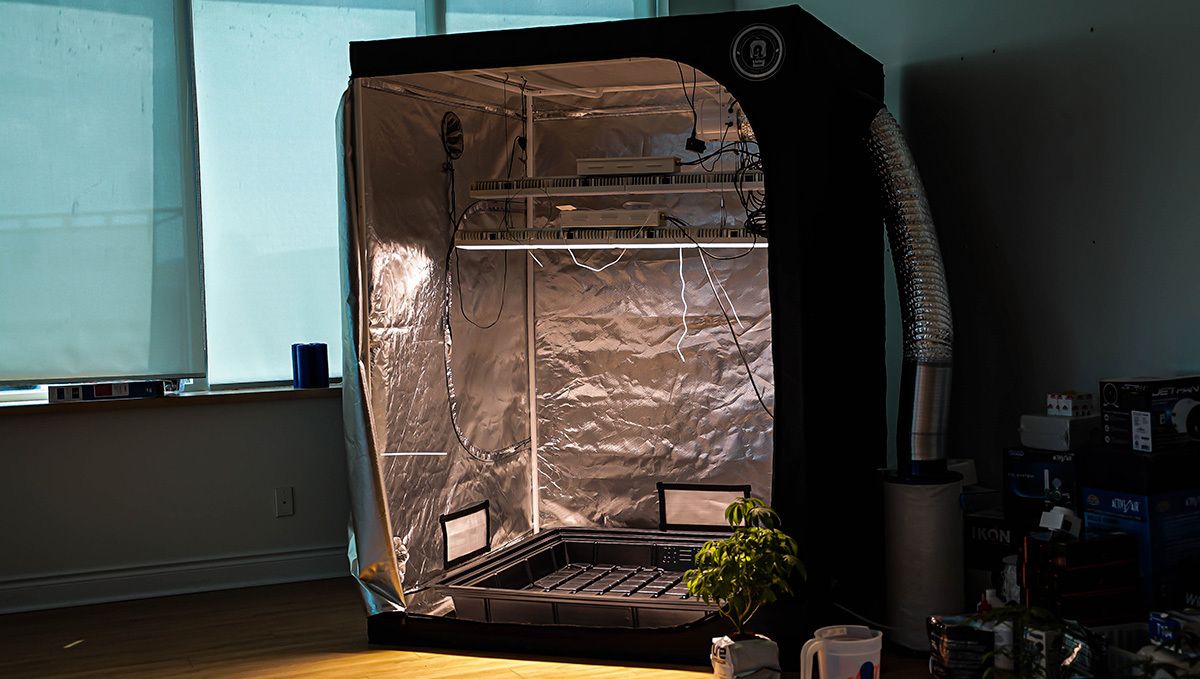
เรื่องแสงรั่วเป็นหนึ่งในสาเหตุที่ทั่วไปที่สุดที่ทำให้พืชกลายเป็นเพศสองในที่สุด ซึ่งอาจทำให้การปลูกเสร็จสิ้นลงได้อย่างรวดเร็ว แต่พืชออโต้ไม่มีปัญหาดังกล่าวเลย แน่นอนว่าปัจจัยอื่น ๆ อาจทำให้พืชกลายเป็นเพศสอง แต่การแสงรั่วไม่เป็นอันตรายสำหรับสายพันธุ์กัญชาออโต้
เปอร์เซ็นต์ CBD สูง
พ่อพันธุ์ของพืชออโต้คือกัญชาสายพันธุ์รูเดอราลิส มีเปอร์เซ็นต์ของสาร CBD สูงกว่าสายพันธุ์ซาติว่าหรืออินดิก้าโดยธรรมชาติ นั่นไม่ได้หมายความว่าสายพันธ์ุซาติว่าหรืออินดิก้านั้นไม่มีสาร CBD อยู่เลย แต่สายพันธุ์ออโต้โดยทั่วไปมีเปอร์เซ็นต์ของ CBD ที่สูงกว่าเล็กน้อยเมื่อเปรียบเทียบกับสายพันธุ์โฟโต้
เหมาะสำหรับทั้งผู้ปลูกมือใหม่และผู้ปลูกที่มีประสบการณ์
ด้วยการได้เปรียบทั้งหมดที่กล่าวถึงข้างต้น สายพันธุ์กัญชาแบบออโต้เป็นทางเลือกที่ดีสำหรับผู้ที่ต้องการเริ่มต้นปลูกกัญชา มีความง่ายในการปลูกพร้อมทั้งมีศักยภาพในการให้ผลผลิตที่ดี ในปัจจุบันนี้สายพันธุ์กัญชาแบบออโต้มีค่า THC และ CBD ที่สูง เสมือนกับสายพันธุ์โฟโต้ แม้ว่าผู้ปลูกที่มีประสบการณ์มาอย่างยาวนานแล้วก็เริ่มเปลี่ยนไปปลูกสายพันธุ์แบบออโต้
แล้วข้อเสียของกัญชาอัตโนมัติล่ะ?
แน่นอนว่ามีบางประการที่สายพันธุ์ออโต้ไม่สามารถเทียบเท่ากับสายพันธุ์โฟโต้ได้ แต่นี้ขึ้นอยู่กับวิธีการปลูกที่คุณต้องการ
สายพันธุ์ออโต้ไม่สามารถทำการโคลนได้
และด้วยคุณสมบัติการตั้งเวลาที่ใช้งานง่ายนั้น สายพันธุ์กัญชาแบบออโต้ไม่สามารถทำการโคลนได้เลย การตัดกิ่งที่ถูกตัดออกจะเริ่มต้นการเจริญเติบโตในเวลาเดียวกับต้นแม่ ซึ่งจะทำให้ไม่มีเวลาเพียงพอสำหรับกิ่งในการเติบโตก่อนที่จะเริ่มการออกดอก แต่อย่างไรก็ตาม อายุการเจริญเติบโตที่รวดเร็วทำให้คุณสามารถเริ่มต้นจากเมล็ดและเก็บเกี่ยวในช่วงเวลาเดียวกับการโคลนปกติ และไม่ต้องมีการโคลนเลย
ไม่ต้องใช้เทคนิคการฝึกฝนที่มีความเครียดสูง
เทคนิคการฝึกฝนที่มีความเครียดสูง (High-Stress Training Techniques หรือ HST) สามารถให้ผลลัพธ์ที่น่าทึ่งกับพันธุ์กัญชาแบบโฟโต้ได้ วิธีการเช่นการตัดยอด (topping), การตัดแบบ FIM, การพับกองกลางต้น (super cropping), การเพิ่มจำนวนหน่วยเกิดของพืช (monster cropping), และการตัดแต่งใบให้โดดเด่น (schwazzing) ทั้งหมดเป็นเทคนิคที่พัฒนาขึ้นในสิบกว่าปีที่ผ่านมา แต่ไม่แนะนำสำหรับสายพันธุ์กัญชาอัตโนมัติ (autoflowering strains) นั่นเพราะกัญชาอัตโนมัติไม่มีเวลาเพียงพอในการกลับมาจากสภาวะเครียด ซึ่งหมายความว่าการใช้เทคนิคการฝึกฝนแบบนี้จะส่งผลให้ผลผลิตน้อยลงและความเข้มข้นต่ำลง สำหรับกัญชาอัตโนมัติ ควรใช้เทคนิคการฝึกฝนแบบ Low-Stress Training (LST) เพื่อให้ได้ผลลัพธ์ที่ดีที่สุด โดยใช้วิธีผูกลักษณะเป็นหลังและการใช้เครื่องมือช่วยสร้างโครงสร้างเส้นตายในการปลูก (scrogging) สามารถเพิ่มปริมาณผลผลิตสุดท้ายได้ถึง 25% จากน้ำหนักที่ปกติ
2. ประเภทของสารอาหารที่แตกต่างกัน
สารอาหารสามารถมาในรูปแบบที่แตกต่างกันได้ รูปแบบที่พบบ่อยที่สุดคือการผสมน้ำละลาย ผสมกับดิน และเป็นรูปแบบผงที่ใช้เป็นการใส่สารอาหารช้าหรือผสมกับส่วนผสมอื่น ๆ ปกติแล้ว ผู้เริ่มต้นที่ปลูกพืชสามารถถามว่าสารอาหารที่ดีที่สุดคืออะไร? นั่นจะขึ้นอยู่กับความชอบและวิธีการปลูกของคุณ โดยสารอาหารสามารถแบ่งออกเป็นสองประเภทหลักคือสารอาหารอินทรีย์และสารอาหารอนินทรีย์ และมีความแตกต่างกันอย่างมาก ทั้งสองประเภทสามารถมาในรูปแบบทั้งสามที่เรากล่าวถึงไปแล้ว แต่การทำงานของมันแตกต่างกันอย่างสิ้นเชิง
อินทรีย์ หรือ อนินทรีย์?
การใช้สารอาหารอินทรีย์เน้นในการสร้างและรักษาสภาพสังเคราะห์ที่อุดมสมบูรณ์ด้วยจุลินทรีย์เล็กๆ การใช้สารอาหารอินทรีย์จะไม่ให้อาหารตรงไปยังพืชโดยตรง แต่จะเพิ่มความอุดมสมบูรณ์ในสิ่งแวดล้อมที่มีจุลินทรีย์ออกฤทธิ์เพื่อใช้เป็นอาหาร จุลินทรีย์จะย่อยสลายสารอาหารและทำให้มันเป็นรูปที่สะดวกต่อการดูดซึมของพืช เนื่องจากคุณไม่ได้ให้อาหารตรงไปยังพืชโดยตรง พืชจะสามารถเลือกกินสารอาหารและตัดสินใจเองเมื่อจะดูดซึมสารอาหารและปรับสภาพสังเคราะห์ตามต้องการ จึงทำให้เกิดความยากลำบากในการเผชิญกับปัญหาที่เกี่ยวข้องกับสารอาหารที่มีความเหลื่อมล้ำหรือขาดแคลน
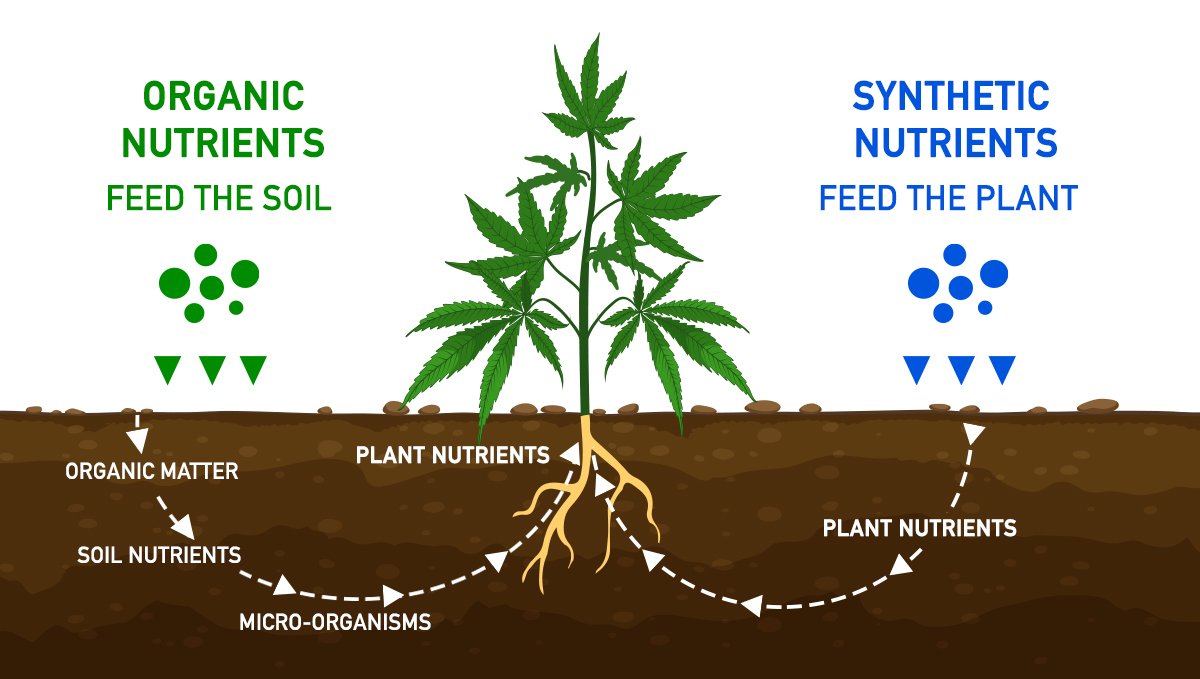
สารอาหารที่ไม่ประกอบด้วยสารอินทรีย์จะทำงานโดยการส่งมอบสารอาหารในปริมาณที่แน่นอนไปยังรากของพืช ในการทำเช่นนี้โดยไม่ทำให้เกิดความเสียหายต่อพืช คุณจะต้องรู้ความต้องการของพืชออโต้อย่างแน่นอนเพื่อที่จะทำได้ สารอาหารที่จำเป็นสำหรับการเจริญเติบโตอย่างมีประสิทธิภาพแตกต่างกันไปในแต่ละสายพันธุ์ ดังนั้น จะเป็นเรื่องยากที่จะทราบได้อย่างแน่นอนว่าควรให้อาหารชนิดใดและเมื่อไหร่ โดยทั่วไปแล้ว คุณจะเริ่มการทดลองและหากคุณเห็นอาการการเจริญเติบโตที่ไม่เต็มที่หรือขาดสารอาหาร คุณก็อาจจะต้องให้อาหารมากขึ้นเล็กน้อย
นอกจากนี้คุณจะต้องปรับปริมาณสารอาหารที่ให้แก่พืชออโต้เพื่อป้องกันการสูญเสียสารอาหาร (สารอินทรีย์) และเพื่อป้องกันการเผาพืชของคุณ (สารอินอร์แอนิก) ผู้ผลิตทั่วไปจะให้คำแนะนำเกี่ยวกับตารางเวลาโดยประมาณและปริมาณสารอาหารที่เหมาะสมสำหรับผลิตภัณฑ์ที่พวกเขาขาย แต่คุณควรจะเริ่มต้นด้วยครึ่งจากปริมาณที่แนะนำสำหรับพืชออโต้
การปล่อยสารอาหารช้า (Slow-release)
สารอาหารช้าที่ปล่อยออกมาเป็นเม็ดหรือรูปแบบผงส่วนใหญ่จะใช้เป็นชั้นคลุมบนดินหรือผสมล่วงหน้ากับดิน นี่เป็นวิธีที่ง่ายที่สุดในการให้ปุ๋ยเพราะวิธีนี้จะปล่อยสารอาหารช้าๆ เมื่อรดน้ำ ดังนั้นคุณไม่ต้องกังวลเรื่องการให้ปุ๋ยให้กับพืชของคุณจนถึงเวลาเก็บเกี่ยวนอกจากคุณสังเกตุเห็นอาการขาดสารอาหาร
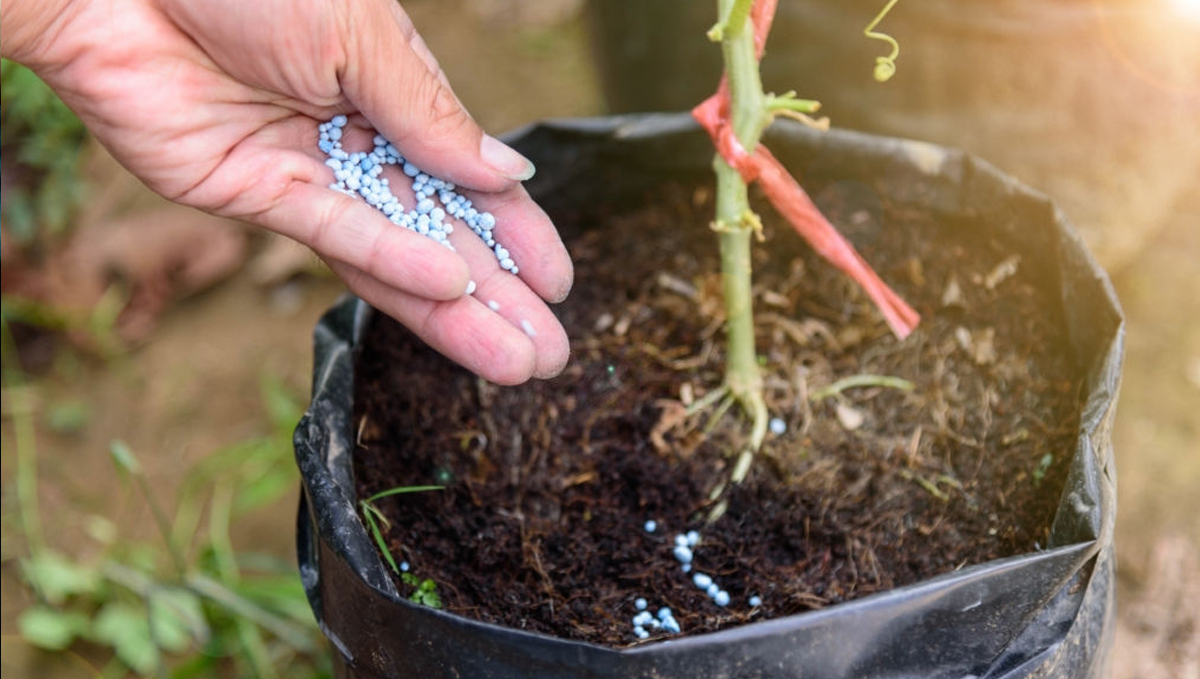
วิธีที่ดีที่สุดในการให้น้ำเมื่อใช้ปุ๋ยชุดที่ปล่อยออกมาช้าคือให้น้ำบ่อยๆ แต่ในปริมาณน้ำเล็กน้อยกว่าเดิม นี้จะทำให้เม็ดหรือผงปุ๋ยละลายเร็วขึ้นและป้องกันปัญหาต่างๆ วิธีการให้อาหารแบบนี้มักจะมาพร้อมกับคำแนะนำที่เขียนสำหรับพืชชนิดโฟโต้ ดังนั้นสำหรับพืชออโต้ แนะนำให้ใช้ปริมาณปุ๋ยครึ่งหนึ่งของปริมาณที่แนะนำ (โดยทั่วไป)
เคล็ดลับ
วิธีการให้อาหารแบบนี้ใช้เวลาสองสามวันในการละลายเม็ดหรือผงถ้าคุณรดน้ำทุกๆ สองสามวัน หากคุณเห็นสัญญาณขาดแคลนหรือเห็นว่าพืชกัญชาออโต้ของคุณต้องการสารอาหาร คุณสามารถใช้สารอาหารที่ละลายในน้ำเป็นประโยชน์เพิ่มเติมเพื่อแก้ไขปัญหานี้ทันทีและให้เวลาให้สารอาหารช้าในการละลายมากขึ้น
สารอาหารบรรจุขวด
สารอาหารปุ๋ยที่บรรจุขวดเป็นสิ่งที่ทุกคนนั้นรู้จัก ไม่ว่าจะเป็นเกษตรกรหรือไม่ก็ตาม ปุ๋ยเหล่านี้มีอยู่ในรูปแบบน้ำและมักจะเป็นปุ๋ยเคมีซึ่งราคาถูกเนื่องจากมีความหลากหลายที่มาก ปุ๋ยเคมีได้รับความนิยมจากเกษตรกรทุกประเภท ถึงแม้ว่ามันจะไม่ปลอดภัยเหมือนปุ๋ยอินทรีย์ คุณยังสามารถปลูกและเก็บเกี่ยวพืชได้โดยไม่มีปัญหาใหญ่ คุณสามารถหาแบรนด์ต่าง ๆ ได้มากมายและคุณภาพอาจแตกต่างกัน แต่ปุ๋ยทุกชนิดจะมีองค์ประกอบเบื้องต้นและอัตราส่วนเดียวกันสำหรับช่วงการเจริญเติบโต (3-1-2) และช่วงดอกไม้บาน (1-2-3) ดังนั้นมันเป็นเรื่องของความชอบแต่ละคน
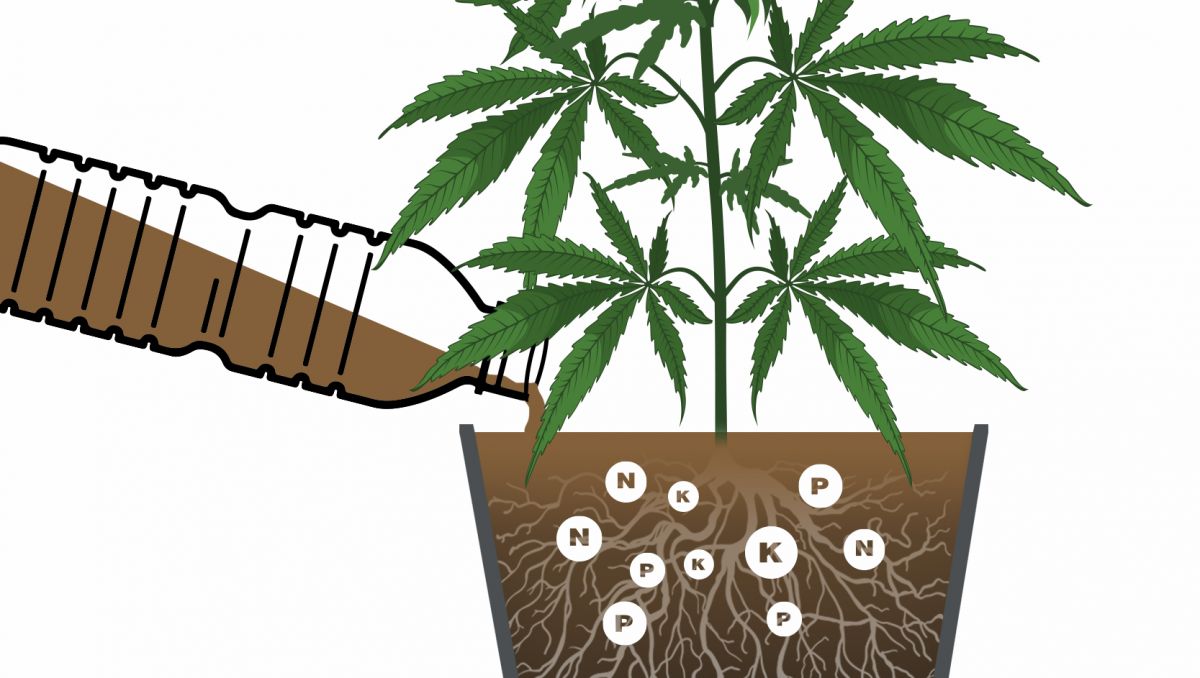
ควรจำไว้ว่า ในการใช้ปุ๋ยอินทรีย์ จะเน้นการสร้างระบบนิเวศในดิน ส่วนปุ๋ยเคมีจะให้อาหารโดยตรงที่รากพืช ดังนั้นคุณอาจทำให้พืชเสี่ยงต่อการไหม้ได้ง่าย ควรเริ่มต้นด้วยปริมาณที่น้อยลงและเพิ่มขึ้นเรื่อย ๆ เพื่อตรวจสอบอาการที่พืชแสดงและปรับปรุงปริมาณอาหารให้เหมาะสมกับความต้องการของพืชของคุณ เพื่อป้องกันการสูญเสียปุ๋ยและสิ่งสำคัญอย่างยิ่งคือการป้องกันการไหม้พืช
ควรจำไว้ว่าเนื่องจากปุ๋ยเคมีเป็นสังเคราะห์และมักจะทำให้เกิดการฆ่าเชื้อจุลินทรีย์ที่อยู่ในดิน ดังนั้น (ขึ้นอยู่กับสภาวะดิน) คุณอาจจะต้องให้ธาตุรองทั้งหมด เช่นแคลเซียมและแมกนีเซียม เป็นต้น
เราขอแนะนำให้ใช้ปุ๋ยชีวภาพเมื่อเป็นไปได้ เพื่อให้คุณรักษาระบบนิเวศที่คล้ายกับที่คุณพบในธรรมชาติ ซึ่งจะทำให้ดอกไม้มีรสชาติที่ดีกว่าและป้องกันการให้อาหารมากเกินไปให้กับพืชออโต้ของคุณ
2.ปุ๋ยสำหรับช่วงระยะต้นกล้า
เมล็ดพันธุ์จะงอกเป็นใบเล็กสองใบที่เรียกว่าใบเลี้ยง (cotyledons) ใบเหล่านี้จะให้สารอาหารที่พืชต้องการในการรอดชีวิตจนกว่าใบจริงแรกจะเริ่มปรากฏขึ้นมา สัปดาห์แรกๆของการเจริญเติบโตของกัญชาเป็นช่วงที่สำคัญมากเนื่องจากต้นกล้าเล็กๆกำลังเริ่มตั้งรากและเป็นอ่อนแอมาก
ควรเริ่มให้อาหารเมื่อไหร่?
หากคุณกำลังให้น้ำและปุ๋ยในช่วงระยะเพาะเมล็ดคุณต้องระมัดระวังที่จะไม่ให้ปุ๋ยเกินไป คุณสามารถเริ่มต้นให้ปุ๋ยกับพืชออโต้ของคุณในปริมาณ 1/8 ของปุ๋ยที่แนะนำหรืออาจเลือกที่จะให้แค่น้ำเฉพาะในช่วงสัปดาห์แรกนี้ หากคุณให้ปุ๋ยมากเกินไปในช่วงการเจริญเติบโตนี้ มีโอกาสที่จะทำให้ต้นเล็กไม่รอดหรือถ้ารอด ผลผลิตทั้งหมดจะมีการลดลงในด้านคุณภาพอย่างมาก
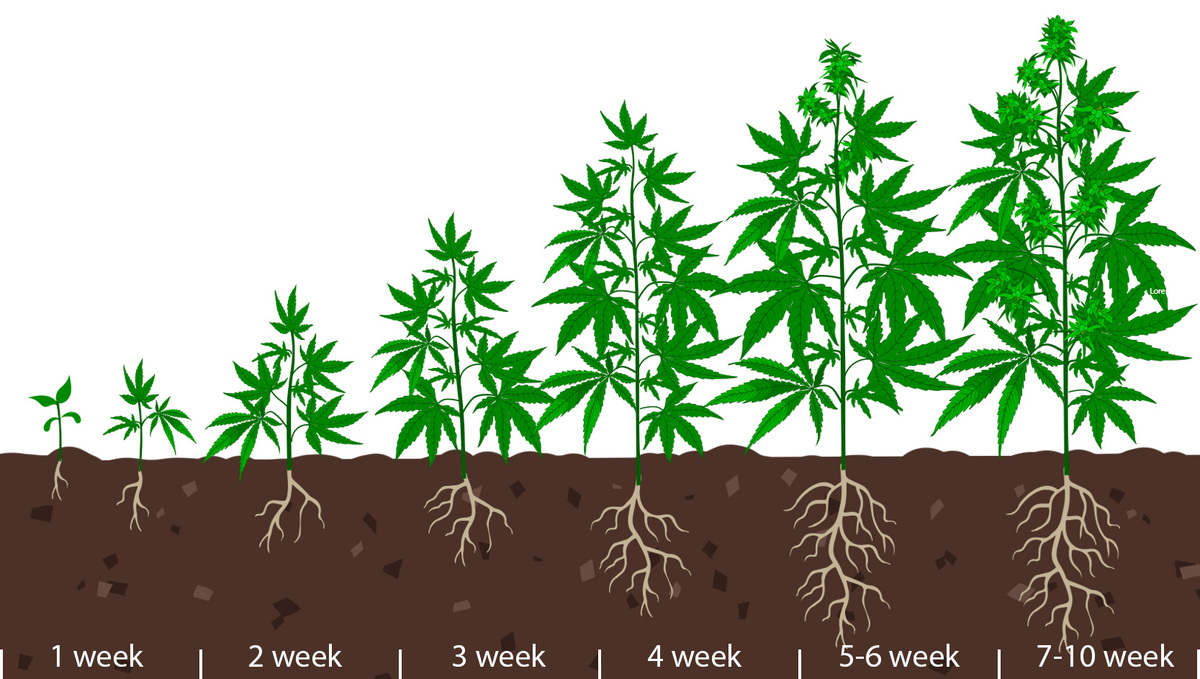
เคล็ดลับ
การให้อาหารที่ละลายน้ำได้ช่วยให้พืชเข้าถึงสารอาหารได้ทันที
หากคุณใช้อาหารที่มีสารอาหารเพิ่มเติม คุณไม่จำเป็นต้องให้อาหารพืชในช่วง 2-3 สัปดาห์แรก (จนถึงระยะก่อนออกดอก) ดังนั้นคุณจึงสามารถผ่อนคลายและลืมสารอาหารเหล่านั้นไปได้เลยในขั้นตอนการเจริญเติบโตนี้
เคล็ดลับ
อ่านคำแนะนำเสมอเนื่องจากอาหารที่ปรับปรุงแล้วมีสารอาหารในปริมาณที่แตกต่างกัน บางชนิดอาจมีปริมาณที่ต้องการสำหรับสัปดาห์แรก แต่บางชนิดอาจมีปริมาณที่ต้องการจนถึงช่วงก่อนดอกบาน
3. ปุ๋ยสำหรับระยะเจริญเติบโตของพืช
ต้นกัญชาสายพันธ์ุช่วงแสงมีระยะการเจริญเติบโตของพืช แต่พืชออโต้จะเปลี่ยนจากระยะต้นกล้าไปสู่การออกดอกโดยตรงโดยไม่จำเป็นต้องเปลี่ยนวงจรแสง
ผู้ปลูกบางคนเชื่อว่าเวลาที่ต้นอ่อนเล็กๆ แตกใบจริงจนกระทั่งเริ่มออกดอกคือระยะการเจริญเติบโตของพืชสำหรับดอกอัตโนมัติ แต่มันไม่สำคัญว่าเราจะเรียกระยะนี้อย่างไร เพราะเราต้องให้อาหารเหมือนกับพืชทั่วไปในระยะเติบโต
เมื่อเราเห็นว่าต้นออโต้ของเราเริ่มเติบโตอย่างรวดเร็ว เราจำเป็นต้องเริ่มให้สารอาหารมากขึ้น โดยปกติแล้ว การให้สารอาหารครึ่งหนึ่งของปริมาณที่แนะนำจะดีที่สุด แต่ถ้าพืชมีพุ่มมาก คุณสามารถให้ปริมาณเต็มที่ได้
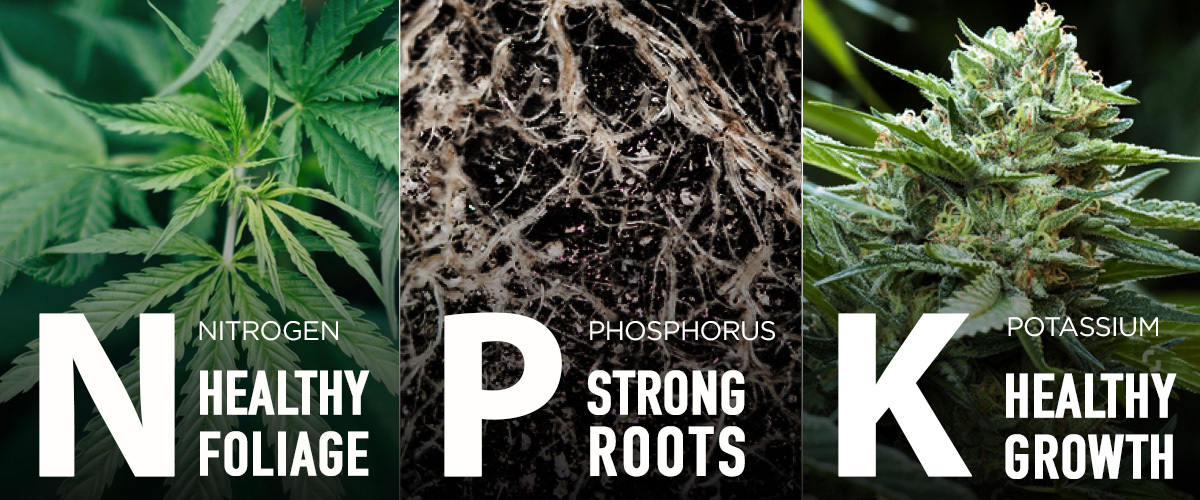
ในขั้นตอนการเจริญเติบโต กัญชาต้องการไนโตรเจน (N) จำนวนมาก และฟอสฟอรัส (P) และโพแทสเซียม (K) ในปริมาณที่เหมาะสม
ไม่ว่าสารอาหารอื่นๆ จะมีเปอร์เซ็นต์เท่าใดก็ตาม ขอให้แน่ใจว่ามีไนโตรเจน (N) มากกว่าธาตุอื่นๆ อีก 2 ธาตุ กัญชาอัตโนมัติยังต้องการธาตุอาหารรองเหล่านั้น แต่ปุ๋ยทางการค้ามักจะมีส่วนผสมของสารอาหารอื่นๆ ที่พืชต้องการในสารละลาย
4. ธาตุอาหารสำหรับระยะก่อนออกดอกและระยะออกดอก
หลังจากผ่านไป 2-3 สัปดาห์ในระยะออกดอก ต้นไม้ของคุณจะโตพอที่จะเริ่มสร้างดอก เมื่อสิ่งนี้เกิดขึ้น ต้นไม้ของคุณจะเริ่มพัฒนาเกสรตัวเมีย ซึ่งเป็นสัญญาณว่าต้นไม้ของคุณกำลังเข้าสู่ระยะก่อนออกดอก
ควรจะเปลี่ยนไปใช้ปุ๋ยช่วงดอกตอนไหน? (bloom nutrients)
เมื่อปรากฏอาการออกดอกครั้งแรก เราจำเป็นต้องเปลี่ยนการให้ปุ๋ยโดยใช้ส่วนผสมของปุ๋ยช่วงการเจริญเติบโตครึ่งส่วนและปุ๋ยช่วงดอกครึ่งส่วน คุณต้องเริ่มนำฟอสฟอรัส (P) และโพแทสเซียม (K) เข้ามาในระบบเรื่อย ๆ
ฟอสฟอรัสเป็นสิ่งจำเป็นสำหรับการผลิตดอกกัญชาและต้องมีให้เมื่อดอกอัตโนมัติของคุณเข้าสู่ระยะออกดอก เมื่อต้นออโต้ของคุณเริ่มผลิตดอกจริง ๆ คุณควรเริ่มให้อาหารเฉพาะปุ๋ยช่วงดอก
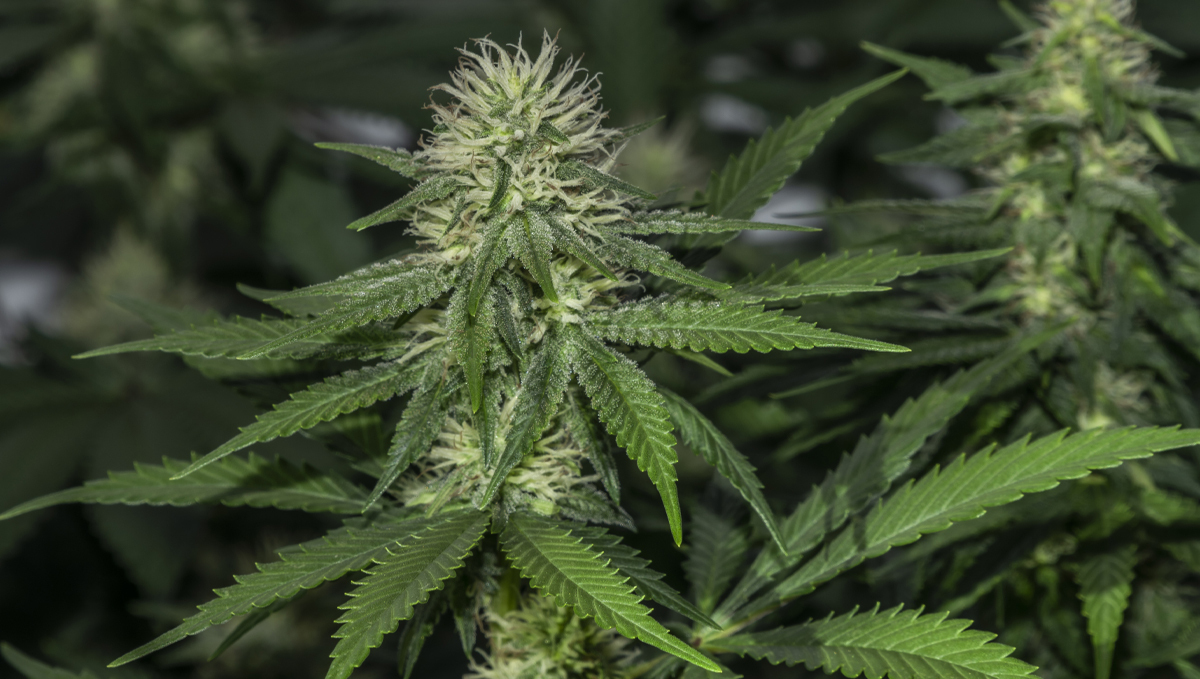
ผู้ปลูกบางคนเชื่อว่าคุณต้องปฏิบัติตามตารางการให้ปุ๋ยอย่างเคร่งครัด ถ้าคุณไม่เปลี่ยนปุ๋ยพืชของคุณจะไม่เจริญเติบโตอย่างเหมาะสม แต่ความจริงคือปุ๋ยเกือบทุกชนิดก็ทำงานได้ดีเพียงพอ คุณสามารถสร้างความแม่นยำได้ถ้าหากคุณมีประสบการณ์มากเพียงพอ คุณสามารถเพิ่มผลผลิตของคุณได้ด้วยปุ๋ยที่เหมาะสม แต่สำหรับผู้ปลูกใหม่และผู้ปลูกระดับกลาง การให้ปุ๋ยไม่ได้เป็นสิ่งสำคัญอย่างที่คิด ทางทีดีที่สุดคือการให้อาหารน้อยกว่าการให้อาหารมากเกินไป
5. ตารางการให้ปุ๋ยสำหรับพืชออโต้ (ปุ๋ยชนิดเหลว)
ต้นกัญชาไม่ชอบการรับปุ๋ยมากเกินไปและอาจทำให้เกิดการเผาไหม้ได้อย่างง่ายดาย ปริมาณปุ๋ยที่ต้องการสำหรับพืชออโต้ขึ้นอยู่กับสายพันธุ์และสภาพแวดล้อมการปลูก ตารางการให้ปุ๋ยต่อไปนี้ควรปรับเปลี่ยนขึ้นอยู่กับเวลาที่พืชเริ่มออกดอก
| ตารางการให้ปุ๋ยสำหรับพืชออโต้ในส่วนปลูกในสารปลูก | ||
|---|---|---|
| สัปดาห์ | ช่วงระยะ | สารอาหาร |
| 1 | ต้นกล้า | น้ำ |
| 2 | ช่วงการเจริญเติบโต | ปุ๋ยช่วงการเจริญเติบโต 1/8 |
| 3 | ช่วงการเจริญเติบโต | ปุ๋ยช่วงการเจริญเติบโต 1/4 |
| 4 | ช่วงก่อนดอกบาน | ปุ๋ยช่วงการเจริญเติบโต 1/2 |
| 5 | อาการแรกของการออกดอก | ¼ ปุ๋ยช่วงดอก + ⅛ ปุ๋ยช่วงเจริญเติบโต |
| 6 | ช่วงออกดอก | ปุ๋ยช่วงดอก 1/2 |
| 7 | ช่วงออกดอก | ปุ๋ยช่วงดอก 1/2 |
| 8 | ช่วงออกดอกและการสุกสมบูรณ์ | ล้างราก (ฟลัช) |
| 9 | การสุกสมบูรณ์และการเก็บเกี่ยว | ล้างราก (ฟลัช) |
ควรจำไว้ว่าการให้ปุ๋ยมากขึ้นไม่ได้หมายความว่าจะมีการเติบโตมากขึ้นเสมอ บางพืชอาจมีการตอบสนองต่อปุ๋ยที่น้อยกว่าพืชอื่นๆ การให้ปุ๋ยเกินไปแก่พืชออโต้ของคุณอาจมีผลกระทบต่อการเก็บเกี่ยว เนื่องจากพืชจะต้องใช้เวลาในการฟื้นตัว และเมื่อเกิดเหตุการณ์นี้ขึ้น (โดยเฉพาะในช่วงดอก) อาจใช้เวลาถึง 7 วันในการฟื้นตัวและเติบโตต่อไปได้อย่างปกติ
หมายเหตุ
แผนการให้ปุ๋ยนี้อ้างอิงจากปริมาณที่แนะนำสำหรับพืชชนิดโฟโต้ ดังนั้นเราใช้ปริมาณเพียง ½, ¼ และ ⅛ ในแผนการให้ปุ๋ยนี้ หากคุณใช้ส่วนผสมปุ๋ยที่มีปุ๋ยสูงอยู่แล้ว คุณควรให้น้ำเท่านั้นจนกว่าคุณจะเห็นอาการดอกเริ่มปรากฏ (ประมาณสัปดาห์ที่ 4) แล้วจึงเริ่มให้ปุ๋ยตามแผนการให้ปุ๋ยนี้ตั้งแต่ช่วงเปลี่ยนเป็นช่วงก่อนดอกบาน
แผนการให้ปุ๋ยอินทรีย์สำหรับพืชออโต้ (ปุ๋ยผง)
สำหรับผู้ปลูกที่เพิ่งเริ่มปลูกกัญชาและพบว่าตารางด้านบนนั้นยากต่อการเข้าใจนิดหน่อย นี่คือตารางที่จะช่วยให้คุณปลูกพืชออโต้ในวิธีอินทรีย์โดยคงความเรียบง่ายไว้
เราขอแนะนำให้ใช้ปุ๋ยคุณภาพที่ดีที่สุดที่คุณสามารถหาได้ แน่นอนว่าในบางสถานที่อาจจะยากที่จะหาได้ ดังนั้นคุณสามารถใช้อะไรก็ได้ตามที่คุณมี ให้มีส่วนผสมของไนโตรเจน (Nitrogen) ฟอสฟอรัส (Phosphorus) และโพแทสเซียม (Potassium) ในอัตราส่วนตามที่กล่าวถึงด้านล่างนี้
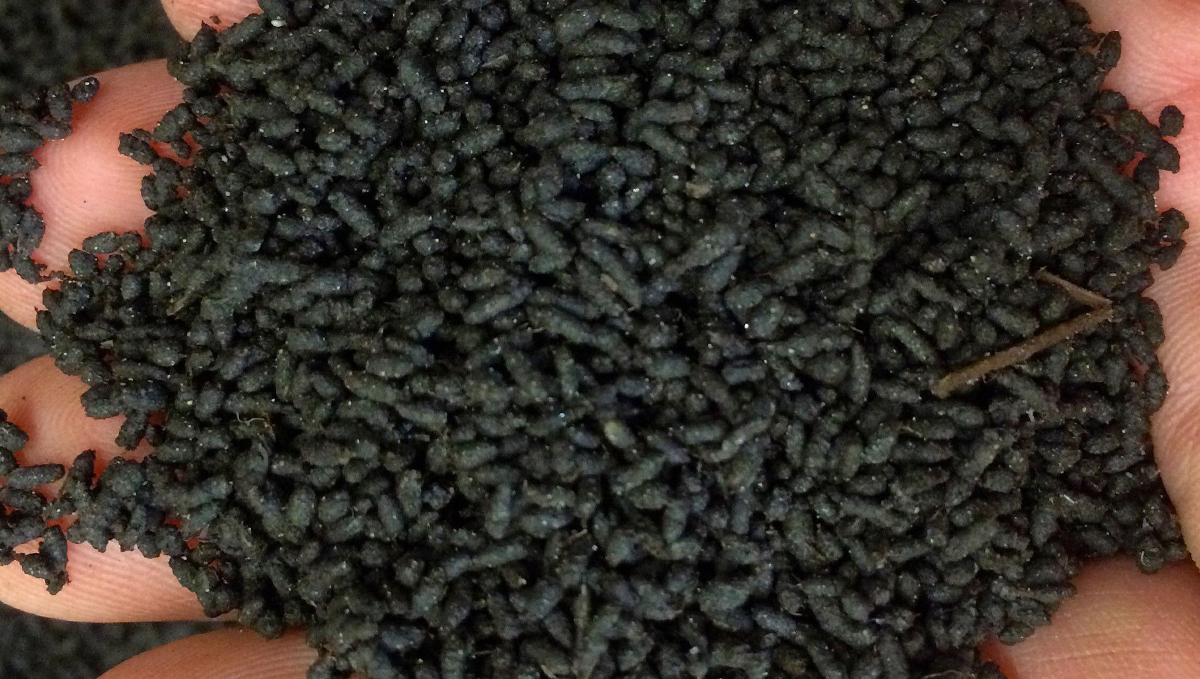
นอกจากนี้ ขึ้นอยู่กับคุณภาพของน้ำที่คุณใช้ คุณอาจจะต้องให้ธาตุอาหารรองเพิ่มเติม ดังนั้นเราขอแนะนำให้ใช้ปุ๋ยที่มีธาตุเสริมที่พืชของคุณต้องการ โดยเฉพาะอย่างยิ่งถ้าคุณใช้น้ำที่ผ่านกรองแล้ว
หากคุณไม่ทราบว่าควรใช้แบรนด์ใด คุณควรสำรวจเกี่ยวกับแบรนด์ Gaia Green, Down to Earth, และ Dr. Earth ซึ่งเป็นแบรนด์ที่ได้รับความนิยมสูงสุดในตลาด อย่างไรก็ตาม เหมือนที่ได้กล่าวมาแล้ว คุณสามารถใช้สารที่คุณต้องการและสิ่งใดก็ได้ที่คุณสามารถหาได้ เพียงแต่ต้องมีส่วนผสมที่เป็นอินทรีย์ 100% และเป็นไปตามอัตราส่วนของ NPK
คุณจะต้องไช้:
- ปุ๋ยทั่วไป 4-4-4
- ปุ๋ยดอก 2-8-4
- หล่อหนอนอินทรีย์
วิธีนี้ประกอบด้วยการเตรียมปรับแต่งส่วนผสมของดินล่วงหน้าและจากนั้นใส่เพิ่มด้วยการปรับปรุงที่ส่วนบนของดินทุก ๆ 2-3 สัปดาห์ อย่างไรก็ตาม การเปลี่ยนแปลงอาจเกิดขึ้นขึ้นอยู่กับเงื่อนไขการปลูกของคุณ เนื่องจากอุณหภูมิที่สูงสามารถเพิ่มความเร็วในกระบวนการฟอสฟอรัสซิสต์ของพืชและดินอาจจะใช้ปริมาณสารอาหารในดินได้เร็วขึ้น
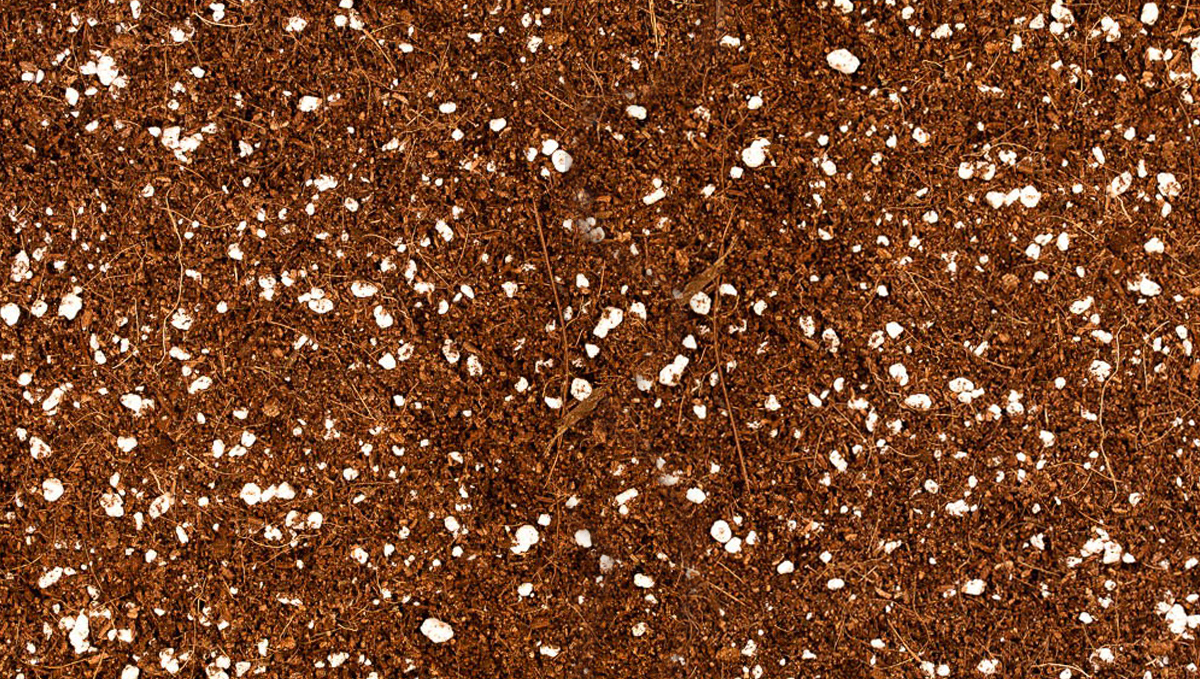
นอกจากนี้บางสายพันธุ์อาจต้องการสารอาหารมากกว่าสายพันธุ์อื่นๆ ดังนั้นขี้หนอนจึงมีบทบาทมาในนั้น; ขี้หนอนจะให้สารอาหารที่มีปริมาณน้อยของสารอาหารทั้งหมดที่พืชของคุณต้องการเพื่อให้เติบโตต่อไปโดยไม่มีความขาดแคลนจนกว่าจะถึงเวลาใส่ขี้หนอนบนดินใหม่
สารเพาะเมล็ด
ประเภทการให้ปุ๋ยนี้สามารถทำได้ในสภาพแวดล้อมการเจริญเติบโตใดก็ได้ที่คุณชอบ แต่เพื่อผลลัพธ์ที่ดีขึ้นเราขอแนะนำให้ใช้ส่วนผสมดังต่อไปนี้:
- ขุยมะพร้าว 90%
- เพอร์ไลท์ 10%
เหมือนที่กล่าวมาก่อนหน้านี้คุณสามารถใช้อะไรก็ได้ตามที่คุณต้องการ แต่สูตรนี้ได้แสดงผลลัพธ์ที่ดีจึงเป็นสิ่งที่เราขอแนะนำ แน่นอนว่าคุณสามารถลองใช้สูตรอื่น ๆ ที่เหมาะกับคุณมากกว่า
โปรดทราบว่าเปอร์เซ็นต์ที่แนะนำด้านล่างนี้ขึ้นอยู่กับจำนวนที่ผู้ผลิตระบุไว้บนบรรจุภัณฑ์!
ขั้นตอนการเจริญเติบโต (ระยะ 1-4 สัปดาห์)
ตารางการให้อาหารนี้ประกอบด้วยการใช้สารอาหารที่เป็นผง ดังนั้นคุณต้องปรับปรุงดินของคุณล่วงหน้าด้วย:
- ปุ๋ยทั่วไป 4-4-4- 75%
- ปุ๋ยช่วงดอก 2-8-4 - 25%
หลังจากที่คุณผสมปุ๋ยในดินแล้ว คุณสามารถดำเนินการต่อและปลูกเมล็ดพันธุ์อัตโนมัติของคุณในกระถางเพื่อให้เมล็ดงอก (หรือหลังจากที่เมล็ดงอกแล้ว) เหล่านี้เป็นการแก้ไขที่ปล่อยออกมาช้าซึ่งใช้เวลาประมาณ 1 สัปดาห์เพื่อให้สารอาหารพร้อมใช้งาน ดังนั้นพวกมันจะไม่ทำให้ต้นอ่อนของคุณไหม้
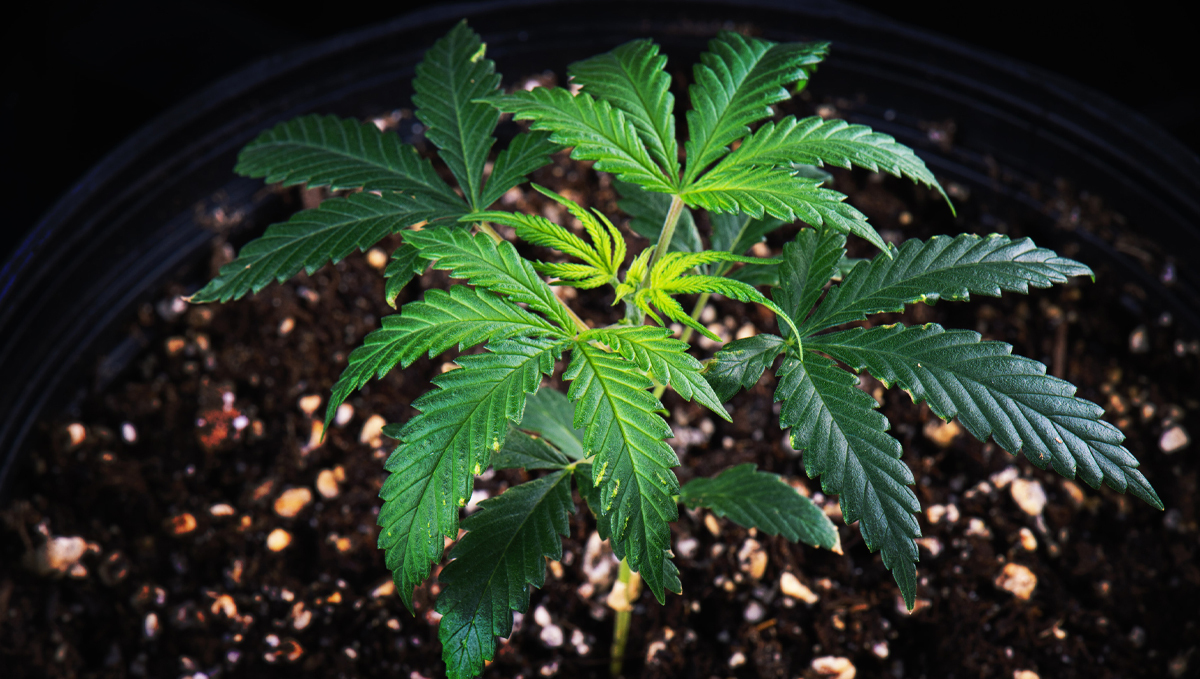
โปรดจำไว้ว่าทุกพันธุ์พืชนั้นแตกต่างกันไป ดังนั้นหากพืชของคุณหิวก่อนการให้อาหารช่วงก่อนดอก คุณสามารถเพิ่มปุ๋ยหมักจากมูลหมาตัวเตี้ยมาใช้ในการให้อาหารด้านบน (top dress feeding) แต่มักจะไม่จำเป็นกับพืชออโต้
ช่วงก่อนการออกดอก (อายุ 5-8 สัปดาห์)
เมื่อปรากฏขึ้นเส้นขนสีขาวครั้งแรก คุณสามารถทำการเติมปุ๋ยดินด้านบนในสภาพแวดล้อมเช่นนี้ได้ด้วย:
- ปุ๋ยทั่วไป 4-4-4: 50%
- ปุ๋ยดอก 2-8-4: 50%
โปรดทราบว่าคุณต้องทาปุ๋ยชนิดผงบนดินอย่างอ่อนโยนจนเกิดการผสมสมบูรณ์และหลังจากผสมเสร็จแล้ว ให้รดน้ำเพื่อให้ปุ๋ยเริ่มย่อยสลาย
ช่วงออกดอก (สัปดาห์ที่ 8 - 10)
ราวๆสัปดาห์ที่ 8 (ประมาณ 2 สัปดาห์ก่อนการเก็บเกี่ยว) พืชของคุณจะต้องการการส่งแรงเพิ่มเติมในการทำให้ดอกโตอย่างเต็มที่ ดังนั้นในช่วงนี้คุณควรให้อาหารพืชของคุณตามอัตราส่วนต่อไปนี้:
- ปุ๋ยทั่วไป 4-4-4 - 30%
- ปุ๋ยดอก 2-8-4 - 70%
การให้อาหารครั้งสุดท้ายนี้จะให้สารอาหารที่จำเป็นในการพัฒนาดอกให้หนาแน่นและเสร็จสิ้นรอบการเจริญเติบโตโดยไม่มีปัญหาใด ๆ
เนื่องจากปุ๋ยเหล่านี้เป็นปุ๋ยอินทรีย์ 100% การล้างรากเป็นเรื่องที่เลือกได้ แต่อย่างไรก็ตาม ขึ้นอยู่กับปุ๋ยที่คุณใช้ คุณอาจต้องล้างรากเพื่อเพิ่มกลิ่นหอมและรสชาติของดอกได้
6. การให้สารอาหารมากเกินไป
การให้อาหารเกินจำนวนเกิดจากสารละลายที่เข้มข้นเกินไป ดังที่กล่าวไว้ข้างต้น ปริมาณสารอาหารที่มากขึ้นไม่ได้หมายความว่าจะได้รับการเจริญเติบโตมากขึ้นเสมอ และบางพันธุ์พืชอาจอ่อนไหวกว่าพันธุ์อื่นๆ
เมื่อคุณไม่ได้วัดปริมาณสารอาหารที่ใส่ลงในสารละลาย คุณอาจให้อาหารมากเกินไปและพืชของคุณจะแสดงอาการที่บ่งชี้ถึงสารพิษ แม้ว่าจะเป็นปัญหาที่พบบ่อยในสวนปลูก ปัญหาที่เกิดขึ้นจะร้ายแรงมากและอาจสิ้นสุดลงด้วยการทำให้พืชของคุณตายได้
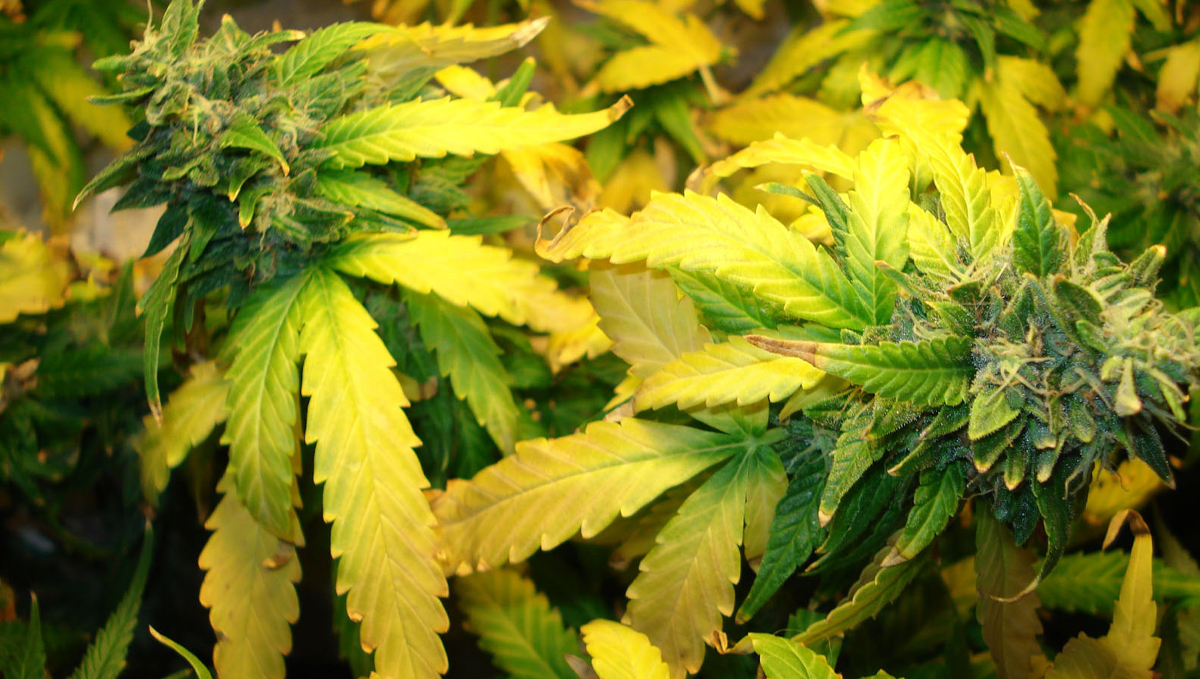
อาการของการให้อาหารมากเกินไปรวมถึงใบเหลืองหรือจุดเหลืองบนใบ และอาจรุนแรงมากขึ้นถ้าคุณไม่แก้ไข หากคุณยังคงให้อาหารที่เข้มข้นแบบเดิม ใบจะเริ่มเป็นสีน้ำตาล แห้งและตาย ซึ่งทำให้พืชเครียดและเติบโตช้าลง อาจผลิตผลผลิตที่น้อยลงและในที่สุดอาจสิ้นชีวิตได้ ดังนั้นหากคุณมองเห็นอาการของสารพิษคุณควรฟลัชทันที ให้พืชของคุณหายใจหายตัวเป็นระยะเวลาสองสามวันและเริ่มให้อาหารอีกครั้งด้วยปริมาณที่ต่ำกว่าที่แนะนำ โดยมีใจที่จะปรับปรุงปริมาณอาหารเพิ่มขึ้นเรื่อย ๆ เพื่อป้องกันได้อย่างง่ายดาย โดยใช้ตารางการให้อาหารสำหรับกัญชาของเราหรือเพียงแค่ให้อาหารในปริมาณที่ต่ำกว่าที่แนะนำและเพิ่มขึ้นเรื่อย ๆ
|
อาการได้รับสารอาหารมากเกินไป |
|
|---|---|
|
ไนโตรเจน
|
ใบเขียวขึ้น แตกกิ่งอ่อน ดูดน้ำน้อยลง |
|
ฟอสฟอรัส
|
ปลายใบไหม้ ใบบาง มีจุดบนใบ |
|
โพแทสเซียม
|
ปลายใบไหม้ ใบล่างม้วน มีจุดบนใบ |
|
แคลเซียม
|
การเจริญเติบโตชะงัก ใบเหี่ยวเฉา |
|
แมกนีเซียม
|
ใบเขียวเข้ม การเจริญเติบโตชะงับ |
7. สารอาหารไม่เพียงพอ
การให้อาหารน้อยเกินไปอาจทำให้พืชของคุณเสียหายได้ หากคุณไม่สามารถให้สารอาหารที่พืชออโต้ของคุณต้องการเพื่อผลิตน้ำตาล พืชจะไม่สามารถเติบโตได้และจะแสดงอาการคล้ายกับอาการของการให้อาหารมากไป แม้ว่าพืชบางชนิดสามารถเติบโตได้ดีหากไม่มีสารอาหาร แต่ขอแนะนำให้คุณใส่ในปริมาณขั้นต่ำเพื่อให้แน่ใจว่าการเก็บเกี่ยวของคุณเป็นไปตามความคาดหวังของคุณ
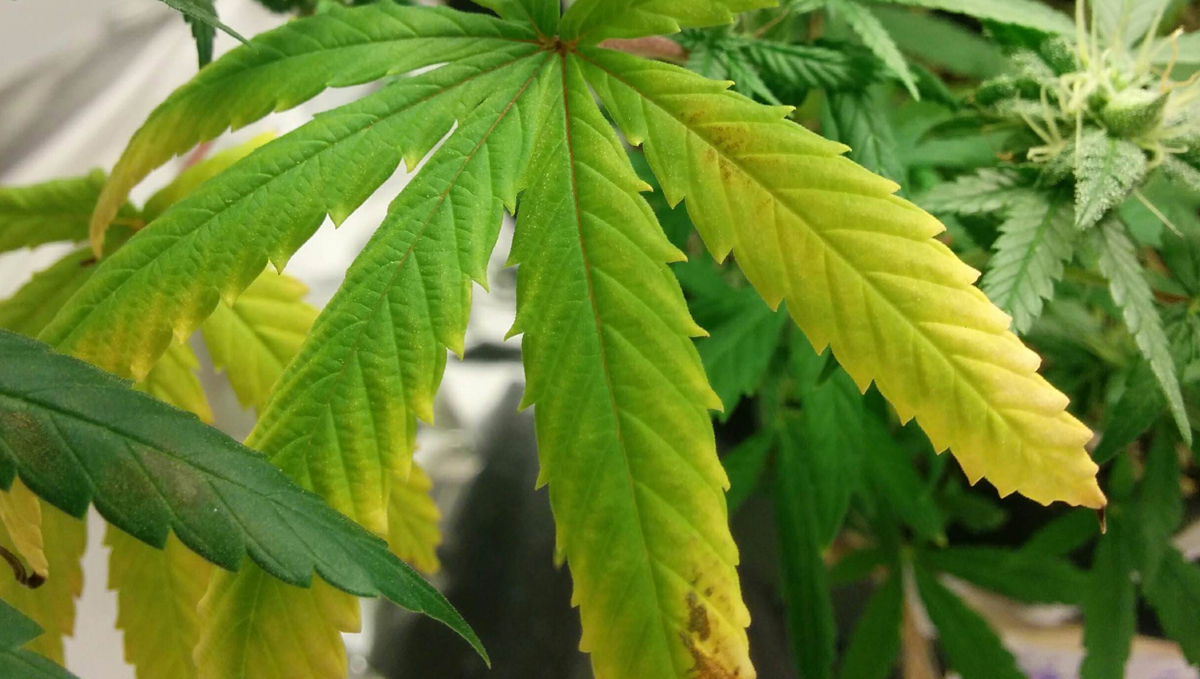
โปรดจำไว้ว่าสารอาหารมีความสำคัญอย่างยิ่ง ดังนั้นแม้ว่าคุณอาจกลัวที่จะให้พืชมากเกินไป แต่ก็ไม่จำเป็นต้องเป็นเช่นนั้น เป็นเรื่องปกติที่ผู้ปลูกมือใหม่จะเผาพืช แม้แต่ผู้ปลูกที่มีประสบการณ์มากก็สามารถเผาพืชได้เมื่อพวกเขากำลังลองใช้สารอาหารยี่ห้อใหม่ ดังนั้น ไม่ต้องกังวล
เพียงให้จำจากการทำความผิดพลาดของคุณและพยายามปรับปริมาณจนกว่าจะถึงปริมาณที่เหมาะสม
|
อาการขาดสารอาหาร |
|
|---|---|
|
ไนโตรเจน
|
ใบเปลี่ยนเป็นสีเหลือง ใบม้วนงอ ใบมีขนาดเล็ก |
|
ฟอสฟอรัส
|
จุดด่างดำบนใบ ใบม้วนงอ การเจริญเติบโตที่ช้า |
|
โพแทสเซียม
|
กิ่งอ่อน ใบสีคล้ายสนิม ออกดอกช้า |
|
แคลเซียม
|
ใบล่างม้วนงอ ออกดอกช้า มีจุดสีน้ำตาลอมเหลืองบนใบ |
|
แมกนีเซียม
|
ใบแห้ง มีจุดคล้ายสีสนิมบนใบ มีอาการป่วย |
8. การล้างราก (flushing) และเวลาที่ควรหยุดให้อาหาร
การล้างราก (Flushing) เป็นกระบวนการที่ใช้ในการล้างสารอาหารที่มีเกินออกจากรากและสารอาหารในสูตรปลูกไปในต้นกล้าของพืชกัญชา กระบวนการนี้จะทำก่อนการเก็บเกี่ยวประมาณ 1-3 สัปดาห์ เมื่อพืชกัญชาดูดซับสารอาหารเข้าไปในตัว อาจมีการสะสมสารอาหารเกิดขึ้น ซึ่งนั่นเกิดขึ้นบ่อยครั้งกับสารอาหารทางเคมีแต่ก็อาจเกิดขึ้นได้กับปุ๋ยอินทรีย์ด้วย ถ้าล้างรากไม่ถูกต้อง อาจมีผลกระทบต่อดอกของพืช พืชที่ไม่ได้รับการล้างรากอย่างถูกต้องจะมีกลิ่นที่ไม่เข้มข้นเท่ากับพืชที่ผ่านการล้างรากและเป็นสารที่กัดเสียงคอ ดังนั้นหากคุณต้องการให้รสชาติและกลิ่นของดอกกัญชาของคุณเด่นชัดและเป็นควันที่นุ่มนวลมลาย แนะนำให้ทำการล้างรากด้วยน้ำปกติหรือผลิตภัณฑ์ที่ใช้สำหรับการล้างรากที่สามารถหาได้ในร้านขายอุปกรณ์การปลูกพืช
9. ยี่ห้อปุ๋ยกัญชาที่ดีที่สุด
ด้วยกฏหมายของหลายๆประเทศในเรื่องกัญชาในปัจจุบัน รายชื่อของแบรนด์ที่ผลิตปุ๋ยคุณภาพสูงสำหรับการปลูกกัญชาก็เพิ่มขึ้นเรื่อย ๆ และในขณะที่มีหลายตัวเลือกก็ไม่เคยเป็นสิ่งที่แย่ แต่อาจทำให้การเลือกปุ๋ยที่เหมาะสมสำหรับการปลูกกัญชาของคุณเป็นเรื่องยากลำบากบ้าง ยี่ห้อไหนคือที่ดีที่สุด? สารเติมตัวไหนที่จะทำให้ดอกนั้นดีขึ้น? เรามาดูกันลึก ๆ เกี่ยวกับแบรนด์ชั้นนำและผลิตภัณฑ์ที่ดีที่สุดที่มีอยู่ในปัจจุบัน!
Advanced Nutrients
Advanced Nutrients ได้เป็นที่รู้จักในวงการตั้งแต่ปี 1999 และจะสามารถบอกได้ว่าพวกเขาเป็นผู้ครองตลาดอย่างแท้จริง พวกเขาเป็นกำลังขับเคลื่อนในการวิวัฒนาการของอาหารปลูกพืช พวกเขาได้พัฒนาสูตรอาหารที่สร้างสรรค์ที่สุดในวงการและเป็นตัวทำให้ผลผลิตที่ดีที่สุดสำหรับการปลูกกัญชาในทุกรูปแบบ พวกเขายังได้รับรางวัล Best Cannabis Nutrient Brand 2022 จาก Grow Diaries ซึ่งเป็นรางวัลที่มีความสำคัญมาก โดยผู้ใช้งานมากมายบนเว็บไซต์ Grow Diaries ได้มีสิทธิ์ลงคะแนนในการเลือกตั้ง ซึ่ง Grow Diaries เป็นเว็บไซต์สมุดปลูกขนาดใหญ่ที่สุดและรางวัลเปิดให้โหวตโดยผู้ที่ลงโพสต์ในเว็บไซต์ แน่นอนว่ารางวัลที่ได้รับจากการแข่งขันกัญชาเช่น The High Times Cannabis Cup และอื่น ๆ อาจมีความเคารพ แต่รางวัลที่มาจากผู้ใช้งานจะช่วยให้เราเข้าใจว่าชุมชนการเพาะปลูกทั้งหมดคิดอย่างไร นอกจากนี้ Advanced Nutrients ยังได้รับรางวัล Best Nutrients 2022 ที่งาน Spannabis - งานแข่งขันกัญชาประจำปีที่ใหญ่ที่สุดในสเปน
ขออธิบายให้ดีครับว่า Advanced Nutrients เป็นแบรนด์ที่มีผลิตภัณฑ์อาหารสำหรับพืชกัญชา โดยมีช่วงผลิตภัณฑ์ที่รองรับด้วยงานวิจัยที่มีพื้นฐานทางวิทยาศาสตร์ พวกเขาเป็นบริษัทที่เป็นตัวนำในการพัฒนาสูตรอาหารที่นวัตกรรมสำหรับการปลูกกัญชา และพวกเขาจัดหาผลิตภัณฑ์ที่ดีที่สุดสำหรับการเพาะปลูกกัญชาในรูปแบบต่างๆ การนำเสนอผลิตภัณฑ์ที่ปรับปรุงการส่งอาหารให้กับพืช ตั้งแต่สายพันธุ์เป็น 3 ส่วน ไปจนถึงผลิตภัณฑ์เช่น Big Bud, Bud Ignitor, Bud Candy และ Voodoo Juice ซึ่งเน้นเฉพาะรากและการมีชีวิตอินทรีย์ในโซนรากของพืช ดังนั้น Advanced Nutrients เป็นชื่อที่ถูกเลือกใช้โดยนักปลูกมืออาชีพที่มีความเชี่ยวชาญในการปลูกกัญชา
ในที่สุด Advanced Nutrients เป็นชุดปุ๋ยที่น่าทึ่งที่ได้รับการสนับสนุนจากการวิจัยและวิทยาศาสตร์ และเป็นตัวเลือกที่ดีสำหรับนักปลูกทุกระดับ ไม่ว่าคุณจะเริ่มต้นการใช้ปุ๋ยครั้งแรกหรือเป็นนักปลูกที่มีประสบการณ์แล้วและกำลังมองหาสายปุ๋ยที่ดีที่สุด Advanced Nutrients เป็นชุดปุ๋ยที่ควรพิจารณา
Canna Nutrients
Canna เป็นบริษัทผู้ผลิตปุ๋ยอีกหนึ่งบริษัทที่มีอยู่ตั้งแต่ต้นและผลิตสายปุ๋ยมาเกือบเท่ากับ Advanced Nutrients ปุ๋ยในสาย Canna ออกแบบมาเพื่อให้การส่งมอบปุ๋ยที่เหมาะสมที่สุด และพวกเขาเน้นให้ความสำคัญกับการให้สูตรปุ๋ยที่ดีที่สุดเพื่อส่งเสริมกระบวนการนำปุ๋ยเข้าสู่พืชให้มีประสิทธิภาพสูงสุดในการดูดซึมปุ๋ย นอกจากสายปุ๋ยแล้วพวกเขายังมีช่วงส่วนเสริมและสำหรับการเจริญเติบโตอื่นๆ เพื่อช่วยให้ระบบปุ๋ยของคุณดำเนินได้ดียิ่งขึ้น Canna ออกแบบสายปุ๋ยให้เข้ากันได้เป็นอย่างดี เมื่อใช้ร่วมกับสำหรับปลูกและส่วนเสริมที่พวกเขามีให้ จะให้การส่งมอบปุ๋ยที่ไม่มีเทียมทาน สายปุ๋ยของพวกเขาได้รับการสนับสนุนด้วยการทดลองในฟิลด์และการทดสอบทางวิทยาศาสตร์ และพวกเขาได้พัฒนาสูตรปุ๋ยที่เหมาะสำหรับการปลูกกัญชา
สายปุ๋ยของ Canna เป็นตัวเลือกที่ดีสำหรับนักปลูกกัญชา เนื่องจากสูตรปุ๋ยของพวกเขาออกแบบมาเพื่อส่งเสริมกระบวนการนำปุ๋ยเข้าสู่พืชให้มีประสิทธิภาพสูงสุดในการดูดซึมปุ๋ย นั่นหมายความว่าพืชของคุณจะสามารถใช้ประโยชน์จากปุ๋ยที่มีอยู่ในถังปุ๋ยอย่างเต็มที่ ซึ่งจะผลักดันให้ได้ผลผลิตมากขึ้น ดอกไม้ที่มีคุณภาพดีขึ้น และประสิทธิภาพในการดูดซึมปุ๋ยที่ดีขึ้น ดังนั้นสายปุ๋ยของ Canna เป็นหนึ่งในตัวเลือกที่ควรพิจารณาเมื่อเลือกปุ๋ยสำหรับการปลูกกัญชา สายปุ๋ยของพวกเขาได้รับการสนับสนุนจากการทดลองในฟิลด์และการทดสอบทางวิทยาศาสตร์ และพวกเขาให้การส่งมอบปุ๋ยที่ไม่เทียมทาน อีกทั้งพวกเขายังมีช่วงสำหรับปลูกและส่วนเสริมที่สามารถช่วยในการติดตั้งระบบปุ๋ยของคุณ ด้วยสายปุ๋ยของ Canna คุณจะได้รับการส่งมอบปุ๋ยและประสิทธิภาพในการดูดซึมปุ๋ยที่ยอดเยี่ยมสำหรับพืชกัญชาของคุณ
Fox Farms
Fox Farms เป็นหนึ่งในบริษัทปุ๋ยและสภาพแวดล้อมที่มีอายุยาวนานที่สุดและได้มอบความสุขกับนักปลูกกัญชาด้วยผลิตภัณฑ์คุณภาพสูงตั้งแต่ปี 1984 โดยเกิดขึ้นในเขตปลูกปัญญากลางของการปลูกกัญชาในฮัมบอลท์คันตี้ ซึ่งตั้งอยู่ที่แถบแปซิฟิกเหนือของประเทศสหรัฐอเมริกา ฟอกซ์ ฟาร์มส์มุ่งเน้นที่จะให้นักปลูกได้ผลิตภัณฑ์ที่ไม่เคยมองเห็นและไม่มีให้แก่เกษตรกรกัญชามาก่อนหน้านี้ - เป็นดินผสมที่ไม่ถูกฆ่าเชื้อที่ถูกออกแบบมาเพื่อปลูกกัญชา
พวกเขานำเสนอสายปุ๋ยที่ออกแบบมาเฉพาะสำหรับระบบไฮโดรโปนิกส์และสูตรปุ๋ยสำหรับพืชที่ปลูกในดิน สายปุ๋ยของ Fox Farms มีประสิทธิภาพสูงและประสิทธิภาพในการดูดซึมปุ๋ยถูกสูงสุดด้วยสูตรปุ๋ยของพวกเขา นอกจากนี้พวกเขายังมีช่วงสำหรับส่วนผสมที่ช่วยให้คุณปรับระดับปุ๋ยและได้รับการส่งมอบปุ๋ยที่ดีที่สุด Fox Farms สายปุ๋ยเป็นตัวเลือกที่ยอดเยี่ยมสำหรับการปลูกกัญชาเนื่องจากได้รับการทดสอบและพิสูจน
General Hydroponics
ชื่อของพวกเขาอาจเปิดเผยความหมายได้บ้างนิดหน่อย แต่ General Hydroponics เป็นผู้นำแท้จริงในการปลูกพืชแบบไฮโดรตั้งแต่วันแรกที่เขาเริ่มต้น ตารางปุ๋ยที่ง่ายต่อการใช้งานและง่ายต่อการเรียนรู้ของพวกเขาได้รับความนิยมมาตั้งแต่วันที่เปิดตัวในตลาด และสามารถเห็นได้อย่างชัดเจนว่ามันทำงาน และมีผลลัพธ์ที่น่าทึ่ง
ปุ๋ยของ General Hydroponics เป็นตัวเลือกที่ยอดเยี่ยมสำหรับการปลูกกัญชา เนื่องจากพวกเขาออกแบบมาเพื่อให้การส่งมอบปุ๋ยและการดูดซึมปุ๋ยเป็นไปตามเกณฑ์ที่เหมาะสม ซึ่งจะช่วยส่งเสริมกระบวนการดูดซึมปุ๋ยถูกสูงสุดและประสิทธิภาพในการดูดซึมปุ๋ยสูงสุดในพืชของคุณ General Hydroponics เส้นทางปุ๋ยได้รับการพัฒนาด้วยความรอบคอบและความแม่นยำตามหลักวิทยาศาสตร์ นี้หมายความว่าพวกเขาให้การส่งมอบปุ๋ยที่ดีเลิศ โดยรวมแล้ว สายปุ๋ยของ General Hydroponics เป็นตัวเลือกที่ยอดเยี่ยมสำหรับการปลูกกัญชาเนื่องจากพวกเขามอบปุ๋ยที่มีประสิทธิภาพในการส่งมอบปุ๋ยและการดูดซึมปุ๋ยที่ดีเลิศ นอกจากนี้พวกเขายังมีช่วงสำหรับส่วนผสมที่ช่วยให้คุณปรับระดับปุ๋ยและได้รับการส่งมอบปุ๋ยที่ดีที่สุด กับ General Hydroponics เส้นทางปุ๋ยคุณจะได้รับการส่งมอบปุ๋ยที่ดีและประสิทธิภาพในการดูดซึมปุ๋ยที่ดีที่สุดสำหรับพืชกัญชาของคุณ
House & Garden
House & Garden เป็นหนึ่งในบริษัทปุ๋ยที่มีอายุยาวนานที่สุดในโลกและเป็นหนึ่งในบริษัทที่เน้นปุ๋ยที่เหมาะสำหรับการเพาะปลูกกัญชาอย่างเป็นทางการแรกๆ ในปี 1900 วิลเลี่ยม แวน เดอ ซวาน - นักสวนชาวเนเธอร์แลนด์ผู้ที่รักการเพาะปลูกพืชทุกชนิด - ตัดสินใจที่จะใช้วิธีวิทยาศาสตร์ในการผสมกลิ่นดอกกุหลาบ ผลลัพธ์ที่ได้คือดอกกุหลาบที่ดีที่สุดในโลก และพวกเขากลายเป็นผู้จัดหาดอกไม้ส่งให้เฉพาะแก่ซานตาส่วนที่ผ่านมา 25 ปีที่แล้วพวกเขาเล็งเป้าที่การเพาะปลูกกัญชาและออกสูตรปุ๋ยที่เหมาะสมเฉพาะกับการเพาะปลูกกัญชา และตอนนี้ได้ผลิตปุ๋ยและสารเสริมขายดีที่สุดในตลาด
บริษัท House & Garden เสนอสายอาหารที่มีการส่งอาหารไปถึงพืชอย่างมีประสิทธิภาพ ด้วยประสิทธิภาพในการนำอาหารเข้าไปในพืชที่ไม่เหมือนใคร และมาพร้อมกับตารางอาหารที่ใช้ง่ายและสามารถปรับแต่งได้ตามความต้องการของคุณ สายส่งตัวกระตุ้นการเจริญเติบโตก็เป็นหนึ่งในที่ดีที่สุด อย่างเช่น Roots Excelurator และ Shooting Powder ซึ่งได้รับรางวัลอันดับหนึ่งหลายรางวัลตั้งแต่วางจำหน่ายออกมา
ส่วนผสมของเส้นใยโคโคที่ได้รับการเตรียมล่วงหน้าของพวกเขาเป็นความเลือกของเรา และน้ำปุ๋ยโคโคที่ผลิตโดย House & Garden ก็เป็นน้ำปุ๋ยโคโค่แบบขวดแรกที่เราเคยใช้ พวกเขาให้ผลลัพธ์ที่ดีกว่าผลิตภัณฑ์ของคู่แข่งและเป็นผลิตภัณฑ์ที่เราแนะนำเป็นอันดับแรกสำหรับการปลูกในโฮมโคโค นอกจากนี้พวกเขายังมีชุดเริ่มต้นที่มาพร้อมกับทุกอย่างที่เจ้าของสวนจำเป็นต้องใช้ ทั้งนี้ราคาถูกมาก อย่างเหมาะสำหรับผู้ที่เพิ่งเริ่มต้นและต้องการเตรียมคลังอุปกรณ์ที่จำเป็น
ตัวเลือกอื่นๆที่ยอดเยี่ยม
หนึ่งในสิ่งที่ดีที่สุดของตลาดปุ๋ยคือการแข่งขันที่มีมากมาย รายชื่อไม่มีที่สิ้นสุดเกือบจะไม่มีที่จบ และถึงแม้ว่าสิ่งที่กล่าวมาข้างต้นจะเป็นตัวเลือกของเรา แต่ยังมีตัวเลือกอื่นๆ มากมายที่มีอยู่สำหรับผู้ปลูกในปัจจุบัน
- Dyna-Gro
- Botanicare
- Cyco
- SHOGUN
- Xpert
- Kyle Kushman’s Vegamatrix
รายชื่อจริงๆแล้วนั้นเยอะมาก สิ่งที่เราแนะนำคือให้คุณไปหาผู้จัดจำหน่ายฮายโดรในพื้นที่ของคุณและพูดคุยเกี่ยวกับตัวเลือกที่มีอยู่ในสต็อก พวกเขายังมักจะมีส่วนลด ดังนั้นอาจคุ้มค่าที่จะสั่งซื้อผลิตภัณฑ์หลายรายการเพื่อเตรียมสต็อกไว้ ทุกสารอาหารจะมีประโยชน์ที่แตกต่างกัน แต่ทั้งหมดเป็นการลงทุนสำหรับการเก็บเกี่ยวในอนาคตของพืชของคุณ
10. สรุป
การให้น้ำแก่ต้นไม้ออโต้ควรดำเนินการอย่างระมัดระวัง เพราะไม่ว่าจะเป็นต้นออโต้หรือต้นไม้ชนิดอื่นๆ ทุกต้นมีความแตกต่างกันในเรื่องต่างๆ คุณสามารถทำตามตารางสารอาหารสำหรับต้นออโต้เช่นที่เราได้แนะนำไว้ข้างต้น แต่วิธีที่ดีที่สุดในการให้อาหารกับต้นไม้คือการเข้าใจสภาพแวดล้อมที่คุณกำลังปลูกและพันธุ์ของต้นไม้ที่คุณกำลังปลูก ตัวอย่างเช่น Purple Lemonade ของเราเป็นต้นไม้ที่แข็งแรงและจะเจริญเติบโตได้อย่างดีโดยไม่ต้องใช้สารอาหารเสริมเพิ่มเติม
แต่ด้วยการใช้งานที่เหมาะสมและสารอาหารที่มีคุณภาพ เธอจะสร้างสิ่งมหัศจรรย์อย่างแน่นอน ปริมาณน้ำและสารอาหารที่พืชออโต้ต้องการขึ้นอยู่กับความชื้น อุณหภูมิ การไหลเวียนของอากาศ และพันธุกรรม ดังนั้นเราขอแนะนำให้ใช้เวลากับต้นไม้ของคุณวันละนิด การใส่ใจกับรายละเอียดเล็กๆ น้อยๆ และสัญลักษณ์ที่พืชของคุณมอบให้คุณ คือจุดที่คุณสร้างความแตกต่างระหว่างการปลูกพืชที่โอเคกับพืชที่สวยงามมากๆและแข็งแรง 100% เราสัญญาว่าเธอจะตอบแทนด้วยการออกดอกที่สวยที่สุดที่คุณเคยเห็นมาก่อน!










Comments